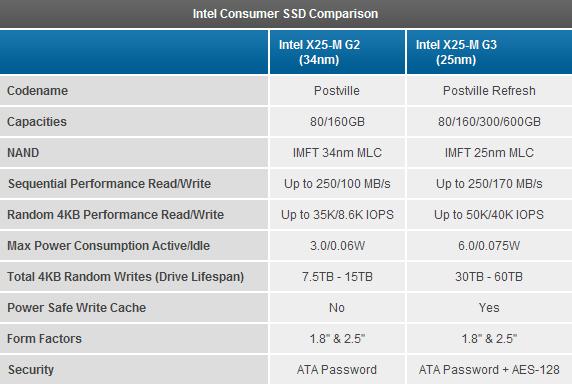Intel's Solid State Drives (SSDs) will be progressing very well in the next few quarters, according to leaked specs obtained by AnandTech. Internally, the improvements are supposedly called the Postville Refresh (the X25-M G2 carried the Postville codename), but externally they will be called by the same X25-M brand we've seen since 2008. Intel is listing the new X25-M as being 3Gbps SATA only, though the SATA implementation has been updated to support ATA8-ACS so 6Gbps is possible once Intel has a chipset with native support.
The third generation drives will be available somewhere between Q4 2010 and Q1 2011 and will feature 25nm IMFT Flash, which means roughly twice the capacity for the same price. The improvements aren't all about price per gigabyte, however, as the 25nm successor will not only get a capacity increase to 600GB for the 2.5-inch size and 300GB for the 1.8-inch, but we'll see up to 40,000 IOPS in random 4K writes, and transfer speeds for larger sequential files up to 250MB/s reads and 170MB/s writes. Furthermore, the new Intel X25-M G3 units are built to last: they're reportedly able to transfer at least 30TB before dying, and have a "power safe write cache" feature that keeps errant power outages from prematurely killing them. Full disk encryption is also included: AES-128 support will be available on consumer drives. We should expect a new version of the SSD Toolbox since Intel is also promising Windows-based firmware updates.

In addition to the new X25-M, a new X25-E, codenamed Lyndonville, will be out in Q1 2011. The first Intel Enterprise SSD to use MLC flash will not be the same MLC used on the consumer drives but rather a modification of the 25nm process that trades data retention for longevity. Standard MLC will last for 12 months after all erase/program cycles have been consumed, while enterprise-grade MLC will last just three months but will instead support many more cycles per cell.
https://www.techspot.com/news/40544-leaked-third-generation-intel-25nm-ssd-specs.html